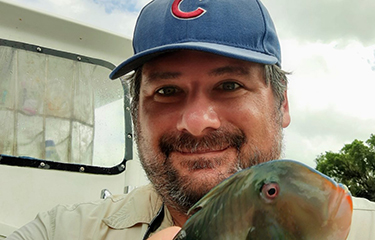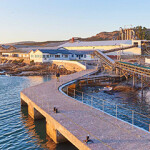University of Hawai’i study finds social media found to be effective research tool for fisheries monitoring

Social media is an effective data-collection tool when studying the activities of recreational fisheries, reducing the limitations of cost and timeliness associated with traditional research methods, according to a new study.
University of Hawai’i at Hilo Adjunct Associate Professor and Hawai'i Cooperative Fishery Research Unit Leader Tim Grabowski was the lead author of the paper, which was published in March 2023 in Aquatic Biology.
The study, “Pandemic-driven changes in the nearshore non-commercial fishery in Hawai’i: catch photos posted to social media capture changes in fisher behavior,” found that studying Instagram pictures posted by noncommercial and non-charter recreational fishers, followed with oral histories directly from fishers to validate social media findings, allowed researchers to efficiently detect changing coastal conditions.
Thanks to higher rates of social media posts with more fish pictured per post during the Covid-19 pandemic, the research team discovered that Hawai’i near-shore recreational fisheries experienced shifts from coastal pelagic fish species to reef fish and spent greater time periods fishing than prior to the pandemic.
“I think that social media has a lot of potential as an early warning system … that can detect changes potentially earlier than on-the-ground surveys that just take more effort and more time, making it harder to pull out those patterns that, in retrospect, become obvious because the Instagram data is much more simplified,” Grabowski said.
The researchers discovered a shift in recreational catch away from pelagic species of yellowfin tuna (ahi), mahi, and wahoo (ono) toward coastal species such as giant trevally (ulua aukea), bluefin trevally (‘omilu), and reef fish. Factors attributed to the shift may be increased targeting of fish for consumption – not just for sport – and the cost of fuel and travel during the pandemic that forced fishers to catch closer to the shoreline, according to Grabowski.
Fishing effort also increased in part due to fewer working hours, increased food insecurity, lower rates of commercial fishing, and a less prohibitive entry to Hawai’i fishing due to easy shoreline access and low cost of fishing gear during the pandemic, according to the study.
Grabowski said social media provides a tool to monitor fishing pressure on stocks in near-shore or recreational fisheries that can fluctuate over time due to economic, social, and food security disruptions, as occurred during the pandemic. The use of social media allows researchers and fisheries managers to analyze a broad view of current harvest estimates and changing conditions in the fisheries faster than traditional data collection would have allowed. That can be especially important in times …
Photo courtesy of




Share